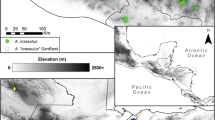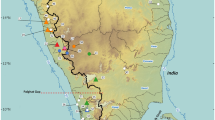Abstract
Symbion americanus was recently described as the second species in the phylum Cycliophora, living commensally on the American commercial lobster Homarus americanus. A previous genetic analysis of American and European populations of cycliophorans suggested that haplotype divergence in S. americanus was much greater than in its European counterpart S. pandora. This study examined the population structure and demographics of 169 individuals thought to belong to S. americanus collected from lobsters over 13 North American localities (Nova Scotia, Canada to Maryland, USA) between October 2003 and January 2006. Cytochrome c oxidase subunit I sequence data clearly suggested the presence of three cryptic lineages in a species complex, often co-occurring in the same lobster specimens. One of these lineages, named the “G” lineage, was represented by very few individuals and therefore was excluded from subsequent statistical analyses. The other two sympatric lineages, named the “T” and “C” lineages, showed different population structure and demography. Although limited geographic structure was found in the T lineage, the C lineage showed higher nucleotide and haplotype diversity values, as well as more variation between localities. The data also indicated that the T lineage underwent a recent population expansion, suggesting that the C and T lineages may have speciated in allopatry but a subsequent population expansion may have been responsible for their current sympatric distribution. Studies on the anatomy and ecology of the sympatric lineages of this species complex should provide further information on the identity of the holotype of S. americanus, which currently cannot be ascribed to any of the three cryptic lineages.



Similar content being viewed by others
References
Aris-Brosous S, Excoffier L (1996) The impact of population expansion and mutation rate heterogeneity on DNA sequence polymorphism. Mol Biol Evol 13:494–504
Baker J, Giribet G (2007) A molecular phylogenetic approach to the phylum Cycliophora provides further evidence for cryptic speciation in Symbion americanus. Zool Scripta (in press)
Bucklin A, Wiebe PH (1998) Low mitochondrial diversity and small effective population sizes of the copepods Calanus finmarchius and Nannocalanus minor: possible impact of climatic variation during recent glaciation. J Hered 89:383–392
Bucklin A, Frost BW, Kocher TD (1995) Molecular systematics of six Calanus and three Metridia species (Calanoida: Copepoda). Mar Biol 121:655–664
Campbell A (1989) Dispersal of American lobsters, Homarus americanus, tagged off southern Nova Scotia. Can J Fish Aquat Sci 46:1842–1844
Campbell A, Stasko AB (1985) Movements of tagged American lobsters, Homarus americanus, off southwestern Nova Scotia. Can J Fish Aquat Sci 42:229–238
Campbell A, Stakso AB (1986) Movements of lobsters (Homarus americanus) tagged in the Bay of Fundy, Canada. Mar Biol 92:393–404
Caporale DA, Beal BF, Roxby R, Van Deneden RJ (1997) Population structure of Mya arenaria along the New England coastline. Mol Mar Biol Biotechnol 6:33–39
Clement M, Posada D, Crandall K (2000) TCS: a computer program to estimate gene genealogies. Mol Ecol 9:1657–1660
Collin R (2001) The effects of mode of development in phylogeography and population structure of North Atlantic Crepidula (Gastropoda: Caplytraeidae). Mol Ecol 10:2249–2262
Cooper RA, Uzmann JR (1980) Ecology of juvenile and adult Homarus. In: Cobb JS, Phillips BF (1980) The biology and management of lobsters, vol 2. Ecology and management. Academic, New York
Cowan DF, Watson WH III, Solow AR, Mountcastle AM (2007) Thermal histories of brooding lobsters, Homarus americanus, in the Gulf of Maine. Mar Biol 150:463–470
Coyne JA, Orr HA (2004) Speciation. Sinauer Associates, Sunderland
Crandall KA (1996) Multiple interspecies transmissions of human and simian T-cell leukemia/lymphoma virus type I sequences. Mol Biol Evol 13:115–131
Crivello JF, Landers DF, Keser M (2005) The genetic stock structure of the American lobster (Homarus americanus) in Long Island Sound and the Hudson Canyon. J Shellfish Res 24:841–848
Cronin TM (1988) Evolution of marine climates of the US Atlantic coast during the past four million years. Philos Trans R Soc Lond B 318:661–678
Dahlgren RG, Weinberg JR, Halanych KM (2000) Phylogeography of the ocean quahog (Arctica islandica): influences of paleoclimate on genetic diversity. Mar Biol 137:487–495
Derycke S, Remerie T, Vierstraete A, Backeljau T, Vanfleteren JR, Vincx M, Moens T (2005) Mitochondrial DNA variation and cryptic speciation within the free-living marine nematode Pellioditis marina. Mar Ecol Prog Ser 300:91–103
Duda TF Jr, Rolán E (2005) Explosive radiation of Cape Verde Conus, a marine species flock. Mol Ecol 14:267–272
Duran S, Rützler K (2006) Ecological speciation in a Caribbean marine sponge. Mol Phylogenet Evol 40:292–297
Estrella B, Morrissey T (1997) Seasonal movement of the offshore American lobster, Homarus americanus, tagged along the eastern shore of Cape Cod, Massachusetts. Fish Bull 95:466–476
Fogarty MJ, Borden DVD, Russell HJ (1980) Movements of tagged American lobster, Homarus americanus, off Rhode Island. Fish Bull 78:771–780
Fu YX (1997) Statistical tests of neutrality of mutations against population growth, hitchhiking and background selection. Genetics 147:915–925
Funch P (1996) The chordoid larva of Symbion pandora (Cycliophora) is a modified trochophore. J Morphol 230:231–263
Funch P, Kristensen RM (1995) Cycliophora is a new phylum with affinities to Entoprocta and Ectoprocta. Nature 378:711–714
Funch P, Kristensen RM (1997) Cycliophora. In: Harrison FW, Woollacott RM (eds) Microscopic anatomy of invertebrates, vol 13. Lophophorates, entoprocta, and cycliophora. Wiley-Liss, New York, pp 409–474
Funch P, Kristensen RM (1999) Cycliophora. In: Knobil E, Neill JD (eds) Encyclopedia of reproduction. Academic, San Diego, pp 800–808
Govindarajan AF, Halanych KM, Cunningham CW (2005) Mitochondrial evolution and phylogeography in the hydrozoan Obelia geniculata (Cnidaria). Mar Biol 146:213–222
Harding GC, Kenchington EL, Bird CJ, Pezzack DS, Landry DC (1997) Genetic relationships among subpopulations of the American lobster (Homarus americanus) as revealed by random amplified polymorphic DNA. Can J Fish Aquat Sci 54:1762–1771
Harpending HC (1994) Signatures of ancient population growth in a low-resolution mitochondrial DNA mismatch distribution. Hum Biol 66:591–600
Hodgins-Davis A, Roberts S, Cowan DF, Atema J, Bennie M, Avolio M, Avolioa C, Defaveri J, Gerlach G (2006) Characterization of SSRs from the American lobster, Homarus americanus. Mol Ecol Notes: online ahead of publication. doi:10.1111/j.1471-8286.2006.01597.x
Jones MW, O’Reilly PT, McPherson AA, McParland TL, Armstrong DE, Cox AJ, Spence KR, Kenchingtong EL, Taggart CT, Bentzen P (2003) Development, characterization, inheritence, and cross-species utility of American lobster (Homarus americanus) microsatellite and mtDNA PCR-RFLP markers. Genome 46:59–69
Knowlton N (1992) Sibling species in the sea. Annu Rev Ecol Syst 24:189–216
Knowlton N, Weigt LA (1997) Species of marine invertebrates: a comparison of the biological and phylogenetic species concept. In: Claridge MF, Dawah HA, Wilson MR (eds) Species: the units of biodiversity. Chapman and Hall, London, pp 199–201
Knowlton N, Weigt LA (1998) New dates and new rates for divergence across the Isthmus of Panama. Proc R Soc Lond B 265:2257–2263
Lee T, Ó Foighil D (2005) Placing the Floridean marine genetic disjunction into a regional evolutionary context using the scorched mussel, Brachiodontes exustus, species complex. Evolution 59:2139–2158
Linton EW (2005) MacGDE: genetic data environment for MacOS X. Ver. 2.0. Software available at http://www.msu.edu/∼lintone/macgde/
López-Legentil S, Turon X (2006) Population genetics, phylogeography and speciation of Cystodytes (Ascidiacea) in the western Mediterranean Sea. Biol J Linn Soc 88:203–214
Machordom A, Macpherson E (2004) Rapid radiation and cryptic speciation in squat lobsters of the genus Munida (Crustacea, Decapoda) and related genera in the South West Pacific: molecular and morphological evidence. Mol Phylogenet Evol 33:259–279
Nedved O (2004) Occurrence of the phylum Cycliophora in the Mediterranean. Mar Ecol Prog Ser 277:297–299
Nichols SA, Barnes PAG (2005) A molecular phylogeny and historical biogeography of the marine sponge genus Placospongia (Phylum Porifera) indicate low dispersal capabilities and widespread crypsis. J Exp Mar Biol Ecol 323:1–15
Obst M, Funch P (2003) Dwarf male of Symbion pandora (Cycliophora). J Morphol 255:261–278
Obst M, Funch P (2006) The microhabitat of Symbion pandora (Cycliophora) on the mouthparts of its host Nephrops norvegicus (Decapoda: Nephropidae). Mar Biol 148:945–951
Obst M, Funch P, Giribet G (2005) Hidden diversity and host specificity in cycliophorans; a phylogeographic analysis along the North Atlantic and Mediterranean Sea. Mol Ecol 14:4427–4440
Obst M, Funch P, Kristensen RM (2006) A new species of Cycliophora from the mouthparts of the American lobster, Homarus americanus (Nephropidae, Decapoda). Org Divers Evol 6:83–97
Pfenniger M, Posada D (2002) Phylogeographic history of the land snail Candidula unifasciata (Helicellinae, Stylommatophora): fragmentation, corridor migration, and secondary contact. Evolution 56:1776–1788
Ramos-Onsins SE, Rozas J (2002) Statistical properties of new neutrality tests against population growth. Mol Biol Evol 19:2092–2100
Remerie T, Bourgois T, Peelaers D, Vierstraete A, Vanfleteren JR, Vanreusel A (2006) Phylogeographic patterns of the mysid Mesopodopsis slabberi (Crustacea, Mysida) in Western Europe: evidence for high molecular diversity and cryptic speciation. Mar Biol 149:465–481
Rogers AR (1995) Genetic evidence for a Pleistocene population explosion. Evolution 49:608–615
Rogers AR, Harpending H (1992) Population growth makes waves in the distribution of pairwise genetic differences. Mol Biol Evol 9:552–569
Rozas J, Sánchez-DelBarrio JC, Messeguer X, Rozas R (2003) DnaSP, DNA polymorphism analyses by the coalescent and other methods. Bioinformatics 19:2496–2497
Rozas J, Sánchez-DelBarrio JC, Messeguer X, Rozas R (2006) DnaSP: DNA sequence polymorphism v. 4.10.8 (Release of July 20, 2006). Software and documentation available at http://www.ub.es/dnasp/
Schneider S, Roessli D, Excoffier L (2000) Arlequin v. 2.000: a software for population genetics data analysis. Genetics and Biometry Laboratory, University of Geneva, Geneva
Schulze A, Cutler EB, Giribet G (2007) Phylogeny of sipunculan worms: a combined analysis of four gene regions and morphology. Mol Phylogenet Evol 42:171–192
Tajima F (1989) Statistical method for testing the neutral mutation hypothesis by DNA polymorphism. Genetics 123:585–595
Tam YK, Kornfield I (1996) Characterization of microsatellite markers in Homarus (Crustacea, Decapoda). Mol Mar Biol Biotechnol 5:230–238
Tarjuelo I, Posada D, Crandall KA, Pascual M, Turon X (2004) Phylogeography and speciation of colour morphs in the colonial ascidian Pseudodistoma crucigaster. Mol Ecol 13:3125–3136
Templeton AR, Crandall KA, Sing CF (1992) A cladistic analysis of phenotypic associations with haplotypes inferred from restriction endonuclease mapping and DNA sequence data. III. Cladogram estimation. Genetics 132:619–633
Tracey ML, Nelson K, Hedgecock D, Shleser RA, Pressick ML (1975) Biochemical genetics of lobsters: genetic variation and the structure of American lobster (Homarus americanus) populations. J Fish Res Board Can 32:2091–2101
Wares JP (2001) Biogeography of Asterias: North Atlantic climate change and speciation. Biol Bull 201:95–103
Wares JP (2002) Community genetics in the Northwestern Atlantic intertidal. Mol Ecol 11:1131–1144
Wares JP, Cunningham CW (2001) Phylogeography and historical ecology of the North Atlantic intertidal. Evolution 55:2455–2469
Acknowledgments
We are indebted to Matthias Obst for his continuous advice and support, which made this study possible. Financial support for this study was provided by the Danish Research Agency (contract grant no. 21-02-0455 to P.F. and G.G.) and by internal funds from the Museum of Comparative Zoology, Harvard University. Three anonymous reviewers provided comments that helped to improve this study.
Author information
Authors and Affiliations
Corresponding author
Additional information
Communicated by J.P. Grassle.
Rights and permissions
About this article
Cite this article
Baker, J.M., Funch, P. & Giribet, G. Cryptic speciation in the recently discovered American cycliophoran Symbion americanus; genetic structure and population expansion. Mar Biol 151, 2183–2193 (2007). https://doi.org/10.1007/s00227-007-0654-8
Received:
Accepted:
Published:
Issue Date:
DOI: https://doi.org/10.1007/s00227-007-0654-8




